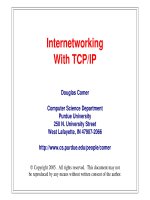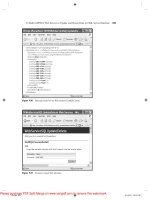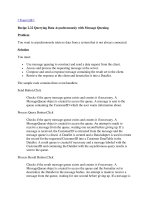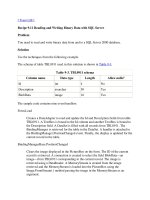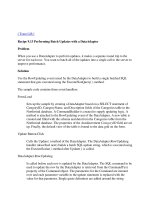Internetworking with TCP/IP- P17 doc
Bạn đang xem bản rút gọn của tài liệu. Xem và tải ngay bản đầy đủ của tài liệu tại đây (430.76 KB, 10 trang )
lnternet Protocol: Error And
Control Messages (ICMP)
9.1
Introduction
The previous chapter shows how the Internet Protocol software provides an unreli-
able, connectionless datagram delivery service by arranging for each router to forward
datagrams.
A
datagram travels from router to router until it reaches one that can deliver
the datagram directly to its final destination. If a router cannot route or deliver a da-
tagram, or if the router detects an unusual condition that affects its ability to forward the
datagram
(e.g., network congestion), the router needs to infornl the original source to
take action to avoid or correct the problem. This chapter discusses a mechanism that
internet routers and hosts use to communicate such control or error information. We
will see that routers use the mechanism to report problems and hosts use it to test
whether destinations are reachable.
9.2
The lnternet Control Message Protocol
In the connectionless system we have described so far, each router operates auto-
nomously, routing or delivering datagrams that arrive without coordinating with the ori-
ginal sender. The system works well if all machines operate correctly and agree on
routes. Unfortunately, no large communication system works correctly all the time.
Besides failures of communication lines and processors, IP fails to deliver datagrams
when the destination machine is temporarily or permanently disconnected from the net-
work, when the time-to-live counter expires, or when intermediate routers become so
130
Internet
Protocol:
br
And Control
Messages
(ICMP) Chap.
9
congested that they cannot process the incoming traffic. The important difference
between having a single network implemented with dedicated hardware and an internet
implemented with software is that in the former, the designer can add special hardware
to inform attached hosts when problems arise. In
an
internet, which has no such
hardware mechanism, a sender cannot tell whether a delivery failure resulted from a lo-
cal malfunction or a remote one. Debugging becomes extremely difficult. The
IP
pro-
tocol itself contains nothing to help the sender test connectivity or learn about such
failures.
To allow routers in an internet to report errors or provide information about unex-
pected circumstances, the designers added
a
special-purpose message mechanism to the
TCP/IP
protocols. The mechanism, known as the
Internet Control Message Protocol
(ICMP),
is considered a required part of
IP
and must be included in every
IP
implemen-
tation.
Like all other traffic,
ICMP
messages travel across the internet in the data portion
of
IP
datagrams. The ultimate destination of an
ICMP
message is not an application
program or user on the destination machine, however, but the Internet Protocol software
on that machine. That is, when an
ICMP
error message arrives, the
ICMP
software
module handles it. Of course, if
ICMP
determines that a particular higher-level proto-
col or application program has caused a problem, it will inform the appropriate module.
We can summarize:
The Internet Control Message Protocol allows routers to send error
or control messages to other routers or hosts; ICMP provides com-
munication between the Internet Protocol sofrware on one machine
and the Internet Protocol sofrware on another.
Initially designed to allow routers to report the cause of delivery errors to hosts,
ICMP
is not restricted to routers. Although guidelines restrict the use of some
ICMP
messages, an arbitrary machine can send an
ICMP
message to any other machine.
Thus, a host can use
ICMP
to correspond with a router or another host. The chief ad-
vantage of allowing hosts to use
ICMP
is that it provides a single mechanism used for
all control and information messages.
9.3
Error Reporting
vs.
Error Correction
Technically,
ICMP
is an
error reporting mechanism.
It provides a way .for routers
that encounter an error to report the error to the original source. Although the protocol
specification outlines intended uses of
ICMP
and suggests possible actions to take in
response to error reports,
ICMP
does not fully specify the action to be taken for each
possible error.
In
short,
Sec.
9.3
Error
Reporting
vs.
Error Correction
When a datagram causes an error,
ICMP
can only report the error
condition back to the original source of the datagram; the source
must relate the error to an individual application program or take
other action to correct the problem.
Most errors stem from the original source, but others do not. Because ICMP re-
ports problems to the original source, however, it cannot be used to inform intermediate
routers about problems. For example, suppose a datagram follows a path through a se-
quence of routers, RI,
R2,
,
Rk.
If
Rk has incorrect routing information and mistakenly
routes the datagram to router RE, RE cannot use ICMP to report the error back to router
Rk; ICMP can only send a report back to the original source. Unfortunately, the original
source has no responsibility for the problem or control over the misbehaving router.
In
fact, the source may not
be
able to detemune which router caused the problem.
Why
restrict ICMP to communication with the original source? The answer should
be clear from our discussion of datagram formats and routing
in
the previous chapters.
A
datagram only contains fields that specify the original source and the ultimate desti-
nation; it does not contain a complete record of its trip through the internet (except for
unusual cases where the record route option is used). Furthermore, because routers can
establish and change their own routing tables, there is no global knowledge of routes.
Thus, when a datagram reaches a given router, it is impossible to know the path it has
taken to arrive there. If the router detects a problem, it cannot know the set of inter-
mediate machines that processed the datagram, so it cannot inform them of the problem.
Instead of silently discarding the datagram, the router uses ICMP to inform the original
source that a problem has occurred, and trusts that host administrators will cooperate
with network administrators to locate and repair the problem.
9.4
ICMP Message Delivery
ICMP messages require two levels of encapsulation as Figure
9.1
shows. Each
ICMP message travels across the internet in the data portion of an
IP
datagram, which
itself travels across each physical network in the data portion of a frame. Datagrams
carryin ICMP messages are routed exactly like datagrams carrying information for
users;
i
ere is no additional reliability or priority. Thus, error messages themselves may
be lost dr discarded. Furthermore, in
an
already congested network, the error message
may cause additional congestion.
An
exception is made to the error handling pro-
cedures if
an
IP
datagram carrying an ICMP message causes an error. The exception,
established to avoid the problem of having error messages about error messages, speci-
fies that ICMP messages are not generated for errors that result from
datagrams carrying
ICMP error messages.
Internet Protocol: Error
And
Control Messages (EMF')
Chap.
9
FRAME FRAME DATA AREA
HEADER
ICMP
HEADER
Figure
9.1
Two levels of
ICMP
encapsulation. The
ICMP
message is encap-
sulated in
an
IP
datagram, which is further encapsulated in
a
frame for transmission. To identify
ICMP,
the datagram protocol
field contains
the
value
I.
ICMP DATA
It is important to keep in mind that even though ICMP messages are encapsulated
and sent using
IP,
ICMP is not considered a higher level protocol
-
it is a required part
of
IP.
The reason for using IP to deliver ICMP messages is that they may need to trav-
el across several physical networks to reach their final destination. Thus, they cannot
be delivered by the physical transport alone.
9.5
ICMP
Message
Format
Although each ICMP message has its own format, they
all
begin with the same
three fields:
an
8-bit integer message
TYPE
field that identifies the message,
an
8-bit
CODE
field that provides further information about the message type, and a 16-bit
CHECKSUM
field (ICMP uses the same additive checksum algorithm
as
IP, but the
ICMP checksum only covers the ICMP message). In addition, ICMP messages that re-
port errors always include the header and first
64
data bits of the datagram causing the
problem.
The reason for returning more than the datagram header alone is to allow the re-
ceiver to determine more precisely which protocol(s) and which application program
were responsible for the datagram. As we will see later, higher-level protocols in the
TCPIIP suite are designed so that crucial information is encoded in the fist
64
bits.
The ICMP
TYPE
field defines the meaning of the message as well
as
its format.
The types include:
Sec.
9.5
ICMP Message
Format
Type Field
0
3
4
5
8
9
10
11
12
13
14
15
16
17
18
ICMP Message Type
Echo Reply
Destination Unreachable
Source Quench
Redirect (change a route)
Echo Request
Router Advertisement
Router Solicitation
Time Exceeded for
a
Datagram
Parameter Problem on a Datagram
Timestamp Request
Timestamp Reply
Information Request (obsolete)
Information Reply (obsolete)
Address Mask Request
Address Mask Reply
The next sections describe each of these messages, giving details of the message format
and its meaning.
9.6
Testing Destination Reachability And Status (Ping)
TCP/IP protocols provide facilities to help network managers or users identlfy net-
work problems.
One of the most frequently used debugging tools invokes the ICMP
echo request
and
echo reply
messages.
A
host or router sends an ICMP echo request
message to a specified destination. Any machine that receives an echo request formu-
lates an echo reply and returns it to the original sender. The request contains an option-
al data area; the reply contains a copy of the data sent in the request. The echo request
and associated reply can be used to test whether a destination is reachable and respond-
ing. Because both the request and reply travel in
IP
datagrams, successful receipt of a
reply verifies that major pieces of the transport system work. First,
IP
software on the
source computer must route the datagram. Second, intermediate routers between the
source and destination must
be
operating and must route the datagram correctly. Third,
the destination machine must be running (at least it must respond to interrupts), and
both ICMP and
IP
software must be working. Finally,
all
routers along the return path
must have correct routes.
On
many systems, the command users invoke to send ICMP echo requests is
named
ping?.
Sophisticated versions of ping send a series of ICMP echo requests, cap-
ture responses, and provide statistics about datagram loss. They allow the user to speci-
fy
the length of the data being sent and the interval between requests. Less sophisticat-
ed versions merely send one ICMP echo request and await a reply.
tDave
Mills once suggested
that
PING is
an
acronym for Packer InrerNer Groper.
134
Internet Protocol: Error And Control Messages
(ICMP)
Chap. 9
9.7
Echo Request And Reply Message Format
Figure
9.2
shows the format of echo request and reply messages.
I
TYPE
(8
or
0)
I
CODE (0)
I
CHECKSUM
I
I
IDENTIFIER
I
SEQUENCE NUMBER
I
OPTIONAL DATA
.
. .
Figure
9.2
ICMP
echo request or reply message format.
The field listed as
OPTIONAL DATA
is
a
variable length field that contains data to
be
returned to the sender.
An
echo reply always returns exactly the same
data
as was re-
ceived in the request. Fields
IDENTIFIER
and
SEQUENCE NUMBER
are
used by the
sender to match replies to requests. The value of the
TYPE
field specifies whether the
message is a request
(8)
or a reply
(0).
9.8
Reports
Of
Unreachable Destinations
When a router cannot forward or deliver
an
IP datagram, it sends a
destination
un-
reachable
message back to the original source, using the format shown
in
Figure
9.3.
TYPE
(3)
I
CODE (0-12)
1
CHECKSUM
UNUSED (MUST BE ZERO)
INTERNET HEADER
+
FIRST
64
BITS OF DATAGRAM
Figure
9.3
ICMP
destination unreachable message format.
The
CODE
field
in
a destination unreachable message contains
an
integer that further
describes the problem. Possible values are:
Sec.
9.8
Reports
Of
Unreachable Destinations
Code Value
0
1
2
3
4
5
6
7
8
9
Meaning
Network unreachable
Host unreachable
Protocol unreachable
Port unreachable
Fragmentation needed and
DF
set
Source route failed
Destination network unknown
Destination host unknown
Source host isolated
Communication with destination
network administratively prohibited
Communication with destination host
administratively prohibited
Network unreachable for type of service
Host unreachable for type of service
Although
IP
is a besteffort delivery mechanism, discarding datagrams should not
be
taken lightly. Whenever an error prevents a router from routing or delivering a da-
tagram, the router sends a destination unreachable message back to the source and then
drops
(i.e., discards) the datagram. Network unreachable errors usually imply routing
failures; host unreachable errors imply delivery failurest. Because the
ICMP
error mes-
sage contains a short prefn of the datagram that camed the problem, the source will
know exactly which address is unreachable.
Destinations may
be
unreachable because hardware is temporarily out of service,
because the sender specified a nonexistent destination address, or (in rare cir-
cumstances) because the router does not have a route to the destination network. Note
that although routers report failures they encounter, they may not know of all delivery
failures. For example,
if
the destination machine connects to an Ethernet network, the
network hardware does not provide acknowledgements. Therefore, a router can contin-
ue to send packets to a destination after the destination is powered down without receiv-
ing any indication that the packets are not being delivered. To summarize:
Although
a
router sends a destination unreachable message when it
encounters a datagram that cannot be forwarded or delivered, a
router cannot detect all such errors.
The meaning of protocol and port unreachable messages will become clear when
we study how higher level protocols use abstract destination points called
ports.
Most
of the remaining messages are self explanatory.
If
the datagram contains the source
route option with
an
incorrect route, it may trigger a
source route
failure message.
If
a
router needs to fragment a datagram but the "don't fragment" bit is set, the router
sends
afragmentation needed
message back to the source.
tAn
exception occurs for routers using the subnet addressing scheme of Chapter
10.
They
report
a sub-
net routing failure
with an
ICMP
host unreachable message.
136
Internet
Protocol: Error
And
Control
Messages
(ICMP) Chap.
9
9.9
Congestion And Datagram Flow Control
Because
JP
is connectionless, a router cannot reserve memory or communication
resources in advance of receiving datagram. As a result, routers can be overrun with
traffic, a condition known as
congestion.
It is important to understand that congestion
can arise for two entirely different reasons. First, a high-speed computer may be able to
generate traffic faster than anetwork can transfer it. For example, imagine a supercom-
puter generating internet traffic. The datagrams may eventually need to cross a slower-
speed wide area network
(WAN)
even though the supercomputer itself attaches to a
high-speed local area net. Congestion will occur in the router that attaches the
LAN
to
the
WAN
because datagrams arrive faster than they can
be
sent. Second, if many com-
puters simultaneously need to send datagrams through a single router, the router can ex-
perience congestion, even though no single source causes the problem.
When datagrams arrive too quickly for a host or router to process, it enqueues
them
in
memory temporarily.
If
the datagrams are part of a small burst, such buffering
solves the problem. If the traffic continues, the host or router eventually exhausts
memory and must discard additional datagram that arrive. A machine uses ICMP
source quench
messages to report congestion to the original source. A source quench
message is a request for the source to reduce its current rate of datagram transmission.
Usually, congested routers send one source quench message for every datagram that
they discard. Routers may also use more sophisticated congestion control techniques.
Some monitor incoming traffic and quench sources that have the highest datagram
transmission rates. Others attempt to avoid congestion altogether by arranging to send
quench requests as their queues start to become long, but before they overflow.
There is no ICMP message to reverse the effect of a source quench. Instead, a host
that receives source quench messages for a destination,
D,
lowers the rate at which it
sends datagrams to
D
until it stops receiving source quench messages; it then gradually
increases the rate as long
as
no further source quench requests are received.
9.10
Source Quench Format
In addition
to
the usual ICMP
TYPE,
CODE, CHECKSUM
fields, and an unused
32-bit field, source quench messages have a field that contains a datagram prefix. Fig-
ure
9.4
illustrates the format. As with most ICMP messages that report an error, the da-
tagram prefix field contains a prefix of the datagram that triggered the source quench re-
quest.
Sec.
9.10
Source Quench Format
137
Figure
9.4
ICMP
source quench message format.
A
congested router sends
one source quench message each time it discards a datagram; the
datagram prefix identifies the datagram that was dropped.
TYPE (4)
9.1
1
Route Change Requests From Routers
Internet routing tables usually remain static over long periods of time. Hosts ini-
tialize them from a configuration file at system startup, and system administrators sel-
dom make routing changes during normal operations.
If
the network topology changes,
routing tables in a router or host may become incorrect.
A
change can be temporary
(e.g., when hardware needs to be repaired) or permanent (e.g., when a new network is
added to the internet). As we will see in later chapters, routers exchange routing infor-
mation periodically to accommodate network changes and keep their routes up-to-date.
Thus, as a general rule:
UNUSED (MUST BE ZERO)
CODE
(0)
Routers are assumed to know correct routes; hosts begin with minimal
routing infonnution and learn new routes from routers.
CHECKSUM
To help follow this rule and to avoid duplicating routing information in the confi-
guration file on each host, the initial host route configuration specifies the minimum
possible routing information needed to communicate
(e.g., the address of a single
router). Thus, the host begins with minimal information and relies on routers to update
its routing table.
In
one special case, when a router detects a host using a nonoptimal
route, it sends the host an ICMP message, called a
redirect,
requesting that the host
change its route. The router also forwards the original datagram on to its destination.
The advantage of the ICMP redirect scheme is simplicity: it allows a host to boot
knowing the address of only one router on the local network. The initial router returns
ICMP redirect messages whenever a host sends a datagram for which there is a better
route. The host routing table remains small but still contains optimal routes for all des-
tinations in use.
Redirect messages do not solve the problem of propagating routes in a general
way, however, because they are limited to interactions between a router and a host on a
directly connected network. Figure
9.5
illustrates the limitation.
In
the figure, assume
source
S
sends a datagram to destination
D.
Assume that router
R,
incorrectly routes
the datagram through router
R,
instead of through router
R,
(i.e.,
R,
incorrectly chooses
